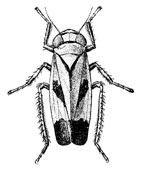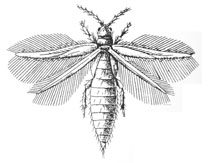

|
 |

- 2 pairs of wings (some species wingless)
- Forewings generally hardened to some extent
- 1mm - 100mm long
- Mouthparts suctorial and developed for piercing
- 80,000 species, 1,700 in Britain
- World-wide
- Habitats: vegetation, some are aquatic
- Almost all are vegetarian, some aquatic species are carnivorous
|
Suborder Heteroptera
- Forewings divided into two regions of different textures
- Wings folded flat over the body at rest
- Head projects horizontally and is visible from above
- Rostrum develops from the front of the head
|
  |
Suborder Homoptera
- Forewings are of uniform texture (membranous or leathery)
- Wings are held like a roof over the back
- Head deflected backwards
- Rostrum develops from the rear of the head
|
  |
To take in enough protein from sap, homopterans have to take in excess sugar. This is often secreted as "honeydew", which may be harvested by ants, or is deposited on the vegetation, where it becomes a medium for fungus.
The loudest insects are the Cicadas, which vibrate a membrane called the tymbal to produce sound and attract females. The sound is officially described as "Tshe -ee -EEE -ou" and a treeful of cicadas can be louder than a pneumatic drill (80-100db)
- 2 pairs of tiny, feather-like wings
- 0.5 - 15mm long
- Mouthparts adapted for piercing and are highly asymmetric
- Yellow, brown or black
- Very narrow body
- Prominent compound eyes
- 5,100 species, at least 5 in Britain
- World-wide, spread on wind currents and with cargoes
- Habitats: vegetation, especially flowers
- Feed on growing vegetation
|
  |
Commonly known as Thunderflies due to the massive swarms which form in still, thundery weather.
The asymmetry of the mandibles occurs because of their method of manipulating food; the left mandible pierces the tissue, and the right maxillary stylet is inserted to draw food into the oral cavity.
- Two pairs of membranous wings, or wingless
- 1-10 mm long
- Biting mouthparts
- Head broad, with bulbous postclypeus
- Small, stocky and soft-bodied
- 3000 species, at least 10 in Britain
- Mainly tropical
- Habitats: in vegetation and under bark, occasionally on books
- Feed on starchy substances, cereal plants, mould (on books)
|
  |
Psocoptera can easily be confused with the small psyllids (Hemiptera) but the most obvious difference is their lack of hemipteroid beak.
- Wingless
- 0.35 - 10mm long
- Narrow head,
- pear-shaped, dorsoventrally flattened body
- Tarsal segments form a single claw
- 500 species, about 50 in Britain
- World-wide
- Ectoparasites on mammals, especially sick or malnourished individuals
- Feed on blood
- See Parasite Biology displays for further information
|
  |
Claws fit the specific shape of the host's hair shaft, making them both host and region specific
- Wingless (adaptation to ectoparasitism)
- 0.35 - 10mm long
- Chewing mouthparts
- Head large and broad
- Very small eyes
- Distinct prothorax on elongate or oval dorsoventrally flattened body
- 3,000 species, about 250 in Britain
- World-wide
- Ectoparasites on birds and some mammals, especially sick or malnourished individuals
- Feed on feathers and hair, plus sebaceous secretions, mucus, sloughed epidermis, lice eggs and nymphs, mites and blood
- See Parasite Biology displays for further information
|
  |
The largest of the Mallophaga is Laembrtothrion circi, measuring 1cm
The mouthparts of the Mallophaga are specifically adapted to the shape of the quill or hair of their host. Mallophaga are also region specific. Lice of larger feathers tend to be longer than lice of the head and neck feathers.
|




















